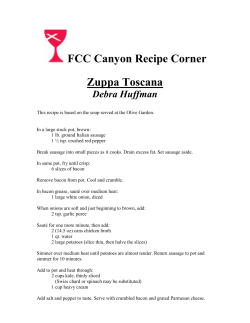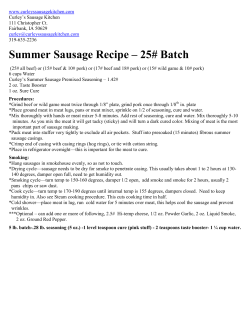
O R E G O N S T... Summer Sausage Tips SP 50-735 Revised March 2013
OREGON STATE UNIVERSITY Extension Service SP 50-735 Revised March 2013 Summer Sausage Tips Summer sausage can be successfully made at home. Recipes can be adapted to make them leaner than their commercial counterparts. Special seasonings can also be added. If you plan to grind your own meat, a meat grinder is recommended. Food processors can be used, but have limited versatility since they will only produce a fine grind. Some grinders come with casing attachments. The best casings are from the small intestine of hogs or sheep. They can usually be purchased from butcher shops that make sausage. Sausage can also be cooked in small cans or just shaped and cooked without a casing. Ingredients Meat: Sausages will be moister and hold together better if there is some fat in the meat. Regular grind beef, lamb, pork, and chicken work well. Venison and turkey might need a little pork or beef fat added. Mixing leaner meats with ground pork will make a leaner product. The standard recipe usually uses 4 pounds of ground venison or turkey to 1 pound of ground pork. Nonfat dry milk: You can add ¼-½ cup of nonfat dry milk per pound of meat to help hold leaner sausage together. Nitrates and Nitrites: Sodium and potassium nitrite and nitrate (saltpeter) have been added to cured meats for centuries. These additives have several purposes. They preserve the red color of meat; they help to give the distinctive cured flavor; and they inhibit the growth of Clostridium botulinum, the bacteria that cause botulism food poisoning. Under certain conditions, nitrite can react with amines from protein to form nitrosamines both in foods and in the digestive tract. Some nitrosamines have been found to cause cancer in animals. Because of this concern, less nitrite is now used for commercial meat curing. Home sausage makers should not use more than the amounts recommended in up-to-date recipes. Seasonings: Common seasonings are mustard seed, coarsely ground pepper, seasoning peppers (like cayenne, chili, or lemon pepper), garlic, and small amounts of thyme, oregano, cloves, and anise seeds. For 1 pound of Meat 1½ tsp. Morton’s Tender Quick salt* ½ tsp. garlic salt ½ tsp. coarse black pepper ½ tsp. mustard seed ¼ tsp. hickory smoked salt or liquid smoke For 5 pounds of Meat 2 Tbsp. Morton’s Tender Quick salt* 2½ tsp. garlic salt 2½ tsp. coarse black pepper 2½ tsp. mustard seed 1 tsp. hickory smoked salt or liquid smoke *Morton’s Tender Quick is not always available locally, but can be ordered from Morton’s salt online store or other online sites. Mixing Mix all the spices together and sprinkle evenly over meat as you mix it. It’s best to use your hands for mixing. Thoroughly wash hands, then knead in the spices. Wash hands well after mixing. Note: If your hands have cuts or are sensitive to salt, you should wear plastic gloves. Curing When the spices are thoroughly mixed into the meat, place it in a covered mixing bowl or in a freezer bag. Refrigerate to cure for at least 24 hours. It’s a good idea to knead the meat mixture at least once during the curing time. Preparing the Sausage for Cooking The sausage can be stuffed into purchased casings, cooked in cans, or just hand shaped. It’s important to keep the diameter of the sausage under 3 inches. Soup cans (10½ ounce) work well to shape the sausage. Spray the cans with a cooking spray or lightly oil them so that the sausage will slip from the cans after the meat is packed into them. Cooking Methods Several methods may be used to cook the sausage: oven, pressure saucepan, or a combination of oven and microwave. The internal temperature of the sausage should reach at least 160°F. to be safe. The amount of time needed will depend on the type of meat you are using as well as other factors. Use an oven thermometer to determine the temperature at the end of the cooking period. Oven Place the sausage rolls on a broiler rack or on a cooling rack placed in a jelly roll pan. Bake in a preheated 200°F. oven for 3-5 hours until the internal temperature of the sausage reaches 160°F. For a drier sausage, continue cooking until the temperature reaches 165°F. The sausage can also be cooked in cans, which have been covered loosely with foil. When the sausage is done, remove from cans and place on paper towels to absorb the fat that has cooked from the sausage. Refrigerate until cool. Microwave/Oven Combination A combination of both the microwave and conventional oven will shorten the baking time and will result in a product more like commercial style summer sausage. Place the sausage rolls on a microwave safe roasting (bacon) rack in the center of the microwave. Cook 10 minutes at 30% (defrost) power. Place the partially cooked sausage rolls on a broiler pan in a preheated 200°F. oven and continue baking for 1-2 hours or until the internal temperature reaches at least 160°F. Remove from oven. Refrigerate until cool. Caution: Because many microwaves do not cook evenly, summer sausage should not be cooked solely in the microwave. The microwave/oven combination gives a good quality product. Sausages should not be cooked in a smoker because the temperature may not be high enough to kill harmful bacteria. Pressure Saucepan Pack the meat tightly into soup cans and cover with foil. Place cans on a roasting rack in the pressure saucepan. Put l cup of water in the bottom of the pan, tighten the lid and place on burner. Follow operating directions that come with the saucepan. Cook 15 minutes at 15 pounds pressure. When cooking time is complete, set the pressure saucepan in a sink filled with cold water and let the cooker cool. Remove the lid when pressure reaches zero. Open pan and carefully remove the cans. Place the cans in cold water to cool, being careful not to let water run into the cans. When the cans are cool, remove sausage and drain on paper towels. Refrigerate until cool. Storage When thoroughly cooled, wrap sausage in foil or plastic and refrigerate or freeze. Cooked sausage can be stored safely in the refrigerator up to 3 weeks. For long-term storage, it may be frozen. Frozen sausage is best quality if used within 2-3 months. NOTE: Raw sausage rolls can be frozen. When ready to use, thaw, then cook following instructions for cooking sausage rolls. Source: OSU Master Food Preserver Program © 2012 Oregon State University. OSU Extension Service cooperating. OSU Extension Service offers educational programs, activities, and materials without discrimination based on race, color, religion, sex, sexual orientation, national origin, age, marital status, disability, or disabled veteran or Vietnam-era veteran status. OSU Extension Service is an Equal Opportunity Employer.
© Copyright 2025















